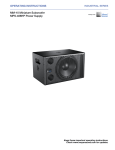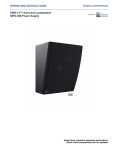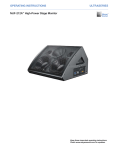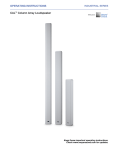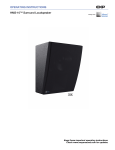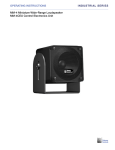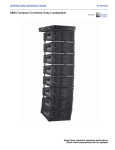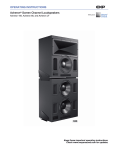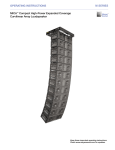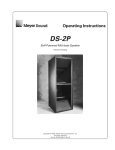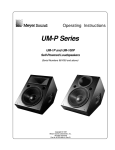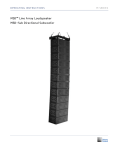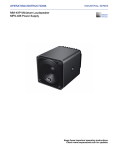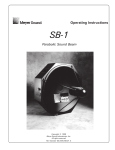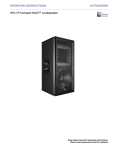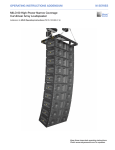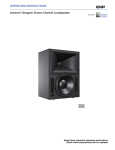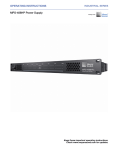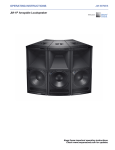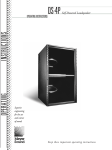Download Meyer Sound Stella-4 Operating instructions
Transcript
OPERATING INSTRUCTIONS INDUSTRIAL SERIES Stella-4 Constellation Installation Loudspeaker Stella-4C Constellation Installation Ceiling-Mount Loudspeaker Stella-8C Constellation Installation Ceiling-Mount Loudspeaker Stella-188 Power Supply Keep these important operating instructions. Check www.meyersound.com for updates. DECLARATION OF CONFORMITY ACCORDING TO ISO/IEC GUIDE 22 AND EN 45014 Manufacturer’s Name: Meyer Sound Laboratories Inc. Manufacturer’s Address: 2832 San Pablo Avenue Berkeley, CA 94702-2204, USA Declares that the product: Product Names: Stella-4 Constellation Installation Loudspeaker Stella-4C Constellation Installation Ceiling-Mount Loudspeaker Stella-8C Constellation Installation Ceiling-Mount Loudspeaker Stella-188 Power Supply Product Options: All Conforms to the following Product Specifications: Safety: EN 60065:2002 IEC 60065:2002 UL 60950:2002 EMC: EN55103-1: 1997 emission1 EN55103-2: 1997 immunity2 This device complies with EN 55103-1 & -2. Operation is subject to the following two conditions: (1) this device may not cause harmful interference, and (2) this device must accept any interference received, including interference that may cause undesired operation Supplementary Information: The product herewith complies with the requirements of the Low Voltage Directive (LVD) 2006/95/EC and the EMC Directive 2004/108/EC. Signature: Ms. Margie Garza Director of Quality Meyer Sound Laboratories Inc. Berkeley, California 94702 USA Issued May 1, 2007 European Contact: Your local Meyer Sound dealer or Meyer Sound Germany, GmbH. © 2011 Meyer Sound. All rights reserved. Stella Operating Instructions, PN 05.161.005.01 B2 The contents of this manual are furnished for informational purposes only, are subject to change without notice, and should not be construed as a commitment by Meyer Sound Laboratories Inc. Meyer Sound assumes no responsibility or liability for any errors or inaccuracies that may appear in this manual. Except as permitted by applicable copyright law, no part of this publication may be reproduced, stored in a retrieval system, or transmitted, in any form or by any means, electronic, mechanical, recording or otherwise, without prior written permission from Meyer Sound. Stella and all alpha-numeric designations for Meyer Sound products and accessories are trademarks of Meyer Sound. Constellation, Meyer Sound, and the Meyer Sound wave logo are registered trademarks of Meyer Sound Laboratories Inc. (Reg. U.S. Pat. & Tm. Off.). All third-party trademarks mentioned herein are the property of their respective trademark holders. ii FEDERAL COMMUNICATIONS COMMISSION (FCC) STATEMENT This equipment has been tested and found to comply with the limits for a Class B digital device, pursuant to part 15 of the FCC Rules. These limits are designed to provide reasonable protection against harmful interference in a residential installation. This equipment generates, uses and can radiate radio frequency energy and, if not installed and used in accordance with the instructions, may cause harmful interference to radio communications. However, there is no guarantee that interference will not occur in a particular installation. If this equipment does cause harmful interference to radio or television reception, which can be determined by turning the equipment off and on, the user is encouraged to try to correct the interference by one or more of the following measures: —Reorient or relocate the receiving antenna. —Increase the separation between the equipment and receiver. —Connect the equipment into an outlet on a circuit different from that to which the receiver is connected. —Consult a Meyer Sound dealer or service representative for help. Properly shielded and grounded cables and connectors must be used in order to meet FCC emission limits. Proper cables and connectors are available from Meyer Sound authorized dealers. Meyer Sound is not responsible for any radio or television interference caused by unauthorized changes or modifications to this equipment. Unauthorized changes or modifications could void the user's authority to operate this equipment. This device complies with Part 15 of the FCC rules. Operation is subject to the following two conditions: (1) this device may not cause harmful interference, and (2) this device must accept any interference received, including interference that may cause undesired operation. INDUSTRY CANADA COMPLIANCE STATEMENT This Class B digital apparatus complies with Canadian ICES-003. AVIS DE CONFORMITÉ À LA RÉGLEMENTATION D'INDUSTRIE CANADA Cet appareil numérique de la classe B est conforme à la norme NMB-003 du Canada. iii SYMBOLS USED These symbols indicate important safety or operating features in this booklet and on the chassis: ! Dangerous voltages: risk of electric shock Important operating instructions Frame or chassis Protective earth ground Pour indiquer les risques résultant de tensions dangereuses Pour indequer important instructions Masse, châssis Terre de protection Warnung vor gefährlicher elektrischer Spannung Wichtige Betriebsanweisung oder Gebrauchsanleitung Rahmen oder Gehäuse Masse Schutzleiter Para indicar voltajes peligrosos Instrucciones importantes de funcionamiento y/o manteniento Armadura o chassis Tierra proteccionista IMPORTANT SAFETY INSTRUCTIONS 1. Read these instructions. 2. Keep these instructions. 3. Heed all warnings. 4. Follow all instructions. 11. Only use attachments/accessories specified by Meyer Sound. 12. If applicable, use only with the caster rails or rigging specified by Meyer Sound, or sold with the loudspeaker. Handles are for carrying only. 5. Do not use this loudspeaker near water. 6. Clean only with dry cloth. 7. Do not block any ventilation openings. Install in accordance with Meyer Sound’s installation instructions. 8. Do not install near any heat sources such as radiators, heat registers, stoves, or other apparatus that produce heat. 9. Do not defeat the safety purpose of the grounding-type plug. A grounding type plug has two blades and a third grounding prong. The third prong is provided for your safety. If the provided plug does not fit into your outlet, consult an electrician for replacement of the obsolete outlet. 10. Protect the power cord from being walked on or pinched, particularly at plugs, convenience receptacles, and the point where they exit from the loudspeaker. The AC mains plug or appliance coupler shall remain readily accessible for operation. iv ! CAUTION: Rigging should only be done by experienced professionals. 13. Unplug this loudspeaker during lightning storms or when unused for long periods of time. 14. Disconnect the mains plug before disconnecting the power cord from the loudspeaker. 15. Refer all servicing to qualified service personnel. Servicing is required when the loudspeaker has been damaged in any way, such as when the power-supply cord or plug has been damaged; liquid has been spilled or objects have fallen into the loudspeaker; rain or moisture has entered the loudspeaker; the loudspeaker has been dropped; or when for undetermined reasons the loudspeaker does not operate normally. CAUTION: To reduce the risk of electric shock, do not expose this loudspeaker to rain or moisture. Do not install the loudspeaker in wet or humid locations without using weather protection equipment from Meyer Sound. ! SAFETY SUMMARY English ■ ■ ■ To reduce the risk of electric shock, disconnect the loudspeaker from the AC mains before installing audio cable. Reconnect the power cord only after making all signal connections. Connect the loudspeaker to a two-pole, three-wire grounding mains receptacle. The receptacle must be connected to a fuse or circuit breaker. Connection to any other type of receptacle poses a shock hazard and may violate local electrical codes. Do not install the loudspeaker in wet or humid locations without using weather protection equipment from Meyer Sound. ■ Do not allow water or any foreign object to get inside the loudspeaker. Do not put objects containing liquid on or near the unit. ■ To reduce the risk of overheating the loudspeaker, avoid exposing it to direct sunlight. Do not install the unit near heat-emitting appliances, such as a room heater or stove. ■ ■ Ne pas installer l’haut-parleur dans un endroit où il y a de l’eau ou une humidité excessive. ■ Ne pas laisser de l’eau ou tout objet pénétrer dans l’haut-parleur. Ne pas placer de r´cipients contenant un liquide sur cet appareil, ni à proximité de celuici. ■ Pour éviter une surchauffe de l’hautparleur, conserver-la à l’abri du soleil. Ne pas installer à proximité d’appareils dégageant de la chaleur tels que radiateurs ou appareils de chauffage. ■ Ce haut-parleur contient des circuits haute tension présentant un danger. Ne jamais essayer de le démonter. Il n’y a aucun composant qui puisse être réparé par l’utilisateur. Toutes les réparations doivent être effectuées par du personnel qualifié et agréé par le constructeur. ■ ■ Um die Gefahr eines elektrischen Schlages auf ein Minimum zu reduzieren, den Lautsprecher vom Stromnetz trennen, bevor ggf. ein Audio-Schnittstellensignalkabel angeschlossen wird. Das Netzkabel erst nach Herstellung aller Signalverbindungen wieder einstecken. ■ Der Lautsprecher an eine geerdete zweipolige Dreiphasen-Netzsteckdose anschließen. Die Steckdose muß mit einem geeigneten Abzweigschutz (Sicherung oder Leistungsschalter) verbunden sein. Der Anschluß der unterbrechungsfreien Stromversorgung an einen anderen Steckdosentyp kann zu Stromschlägen führen und gegen die örtlichen Vorschriften verstoßen. This loudspeaker contains potentially hazardous voltages. Do not attempt to disassemble the unit. The unit contains no user-serviceable parts. Repairs should be performed only by factorytrained service personnel. Pour réduire le risque d’électrocution, débrancher la prise principale de l’hautparleur, avant d’installer le câble d’interface allant à l’audio. Ne rebrancher le bloc d’alimentation qu’après avoir effectué toutes les connections. Branchez l’haut-parleur dans une prise de courant à 3 dérivations (deux pôles et la terre). Cette prise doit être munie d’une protection adéquate (fusible ou coupe-circuit). Le branchement dans tout autre genre de prise pourrait entraîner un risque d’électrocution et peut constituer une infraction à la réglementation locale concernant les installations électriques. Um ein Überhitzen dem Lautsprecher zu verhindern, das Gerät vor direkter Sonneneinstrahlung fernhalten und nicht in der Nähe von wärmeabstrahlenden ■ Haushaltsgeräten (z.B. Heizgerät oder Herd) aufstellen. ■ Im Inneren diesem Lautsprecher herrschen potentiell gefährliche Spannungen. Nicht versuchen, das Gerät zu öffnen. Es enthält keine vom Benutzer reparierbaren Teile. Reparaturen dürfen nur von ausgebildetem Kundenienstpersonal durchgeführt werden. Español ■ Para reducir el riesgo de descarga eléctrica, desconecte de la red de voltaje el altoparlante antes de instalar el cable de señal de audio. Vuelva a conectar la alimentacion de voltaje una vez efectuadas todas las interconexiones de señalizacion de audio. ■ Conecte el altoparlante a un tomacorriente bipolar y trifilar con neutro de puesta a tierra. El tomacorriente debe estar conectado a la protección de derivación apropiada (ya sea un fusible o un disyuntor). La conexión a cualquier otro tipo de tomacorriente puede constituir peligro de descarga eléctrica y violar los códigos eléctricos locales. ■ No instale el altoparlante en lugares donde haya agua o humedad excesiva. ■ No deje que en el altoparlante entre agua ni ningún objeto extraño. No ponga objetos con líquidos encima de la unidad ni cerca de ella. ■ Para reducir el riesgo de sobrecalentamiento, no exponga la unidad a los rayos directos del sol ni la instale cerca de artefactos que emiten calor, como estufas o cocinas. ■ Este altoparlante contiene niveles de voltaje peligrosos en potencia. No intente desarmar la unidad, pues no contiene piezas que puedan ser repardas por el usuario. Las reparaciones deben efectuarse únicamente por parte del personal de mantenimiento capacitado en la fábrica. Deutsch Français ■ ■ ■ ■ Der Lautsprecher nicht an einem Ort aufstellen, an dem sie mit Wasser oder übermäßig hoher Luftfeuchtigkeit in Berührung kommen könnte. Darauf achten, daß weder Wasser noch Fremdkörper in das Innere den Lautsprecher eindringen. Keine Objekte, die Flüssigkeit enthalten, auf oder neben die unterbrechungsfreie Stromversorgung stellen. v vi CONTENTS Chapter 1: Introduction How to Use this Manual Stella Loudspeakers Stella-4C Installation Loudspeaker Stella-4C Installation Loudspeaker Stella-8C Installation Loudspeaker Stella-188 Power Supply Chapter 2: Connecting Stella Loudspeakers Stella Connector Wiring Stella Loudspeaker Cables with Belden 1502 Cable (or Equivalent) Stella-188 Power Supply Stella-188 Front Panel Stella-188 Rear Panel Connecting Stella Loudspeakers to the Stella-188 Chapter 3: Stella Mounting Options Important Safety Considerations Using a Safety Cable with the Stella-4 Mounting the Stella-4 Mounting the Stella-4 with the MMB Bracket Mounting the Stella-4 with the MMB Bracket and OmniMount 20.5 ST Mounting the Stella-4 with the MAMB Adjustable Bracket Mounting the Stella-4C Installing the Stella-4C in a Backbox Mounting the Stella-8C Installing the Stella-8C in a Backbox Appendix A: Stella Specifications 9 9 9 9 10 10 10 11 11 11 12 12 12 16 19 19 19 19 20 20 20 21 21 22 22 23 vii CONTENTS viii CHAPTER 1: INTRODUCTION HOW TO USE THIS MANUAL STELLA LOUDSPEAKERS Make sure to read these operating instructions in their entirety before configuring a system with Stella™ loudspeakers. In particular, pay close attention to material related to safety issues. The Stella family of loudspeakers was engineered primarily for use in Meyer Sound’s Constellation® electroacoustic architecture. The compact, self-powered loudspeakers are ideally suited for applications requiring exceptional audio performance, uniform directional control, low-profile mounting solutions, and remote power supplies. As you read these operating instructions, you will encounter the following icons for notes, tips, and cautions: NOTE: A note identifies an important or useful piece of information relating to the topic under discussion. TIP: A tip offers a helpful tip relevant to the topic at hand. CAUTION: A caution gives notice that an ! action may have serious consequences and could cause harm to equipment or personnel, and could cause delays or other problems. Stella loudspeakers include onboard amplification and processing and exhibit the same high intelligibility, low distortion, and flat frequency and phase responses as other Meyer Sound loudspeakers. Stella Installation Loudspeaker The Stella-4 installation loudspeaker is comprised of a 4inch cone transducer housed in a compact aluminum die cast enclosure. It delivers an impressive frequency range of 100 Hz to 18 kHz and a maximum peak SPL of 108 dB at 1 meter. Information and specifications are subject to change. Updates and supplementary information are available at www.meyersound.com. Meyer Sound Technical Support is available at: ■ Tel: +1 510 486.1166 ■ Tel: +1 510 486.0657 (after hours support) ■ Web: www.meyersound.com/support ■ Email: [email protected] Stella-4 Loudspeaker Mounted with MAMB Adjustable Bracket The Stella-4 can be easily mounted on ceilings or walls with mounting accessories available from Meyer Sound and third-party manufacturers. 9 CHAPTER 1: INTRODUCTION Stella-4C Installation Loudspeaker Stella-188 Power Supply Stella-188 Power Supply Stella-4C Ceiling Mount Installation Loudspeaker The Stella-4C ceiling mount installation loudspeaker offers the same sonic capabilities as the Stella-4 in a package specifically designed for flushmount ceiling and wall applications, where it can be mounted in standard backboxes for 8-inch drivers (with a minimum depth of 4 inches). The Stella-4C is housed in an aluminum die cast enclosure with a rear heat sink. Stella-8C Installation Loudspeaker Stella-8C Ceiling Mount Installation Loudspeaker The Stella-8C ceiling mount installation loudspeaker delivers similar acoustical performance as the Stella-4 and Stella-4C but with expanded output capability and wider coverage. The unit's 8-inch coaxial cone and 0.75-inch tweeter transducers produce a maximum peak SPL of 117 dB at 1 meter over a wide frequency range of 100 Hz to 18 kHz. Housed in an aluminum, die cast enclosure with a rear heat sink, the Stella-8C can be flush-mounted in ceilings and walls with standard backboxes for 8-inch drivers (with a minimum depth of 6.5 inches). 10 The required method of delivering DC power and balanced audio to Stella loudspeakers is with the Stella-188 power supply. The single-space rack unit can power up to 16 Stella-4 or Stella-4C loudspeakers, or up to eight Stella-8C loudspeakers. The Stella-188 receives eight channels of balanced audio from its 25-pin D-sub connector and outputs the audio, along with 18 V of DC power, to its five-pin Phoenix connectors. Each Channel Output can drive up to two Stella-4/Stella-4C loudspeakers (or one Stella-8C loudspeaker). The Stella-188 front panel has LEDs for monitoring voltage output and connectivity to the Stella loudspeakers. Stella loudspeakers receive balanced audio and DC power from a five-pin Phoenix-style connector on their rear panel. Meyer Sound's patented Iso-Input™ transformer-isolated differential inputs yield a high common-mode signal rejection ratio (CMRR). Because Stella loudspeakers have been optimized to tolerate voltage drops of up to 30 percent, they can accommodate light-gauge cables and long cable runs. CHAPTER 2: CONNECTING STELLA LOUDSPEAKERS STELLA CONNECTOR Stella loudspeakers receive DC power and balanced audio from a five-pin Phoenix connector on their rear panel. The connector’s five pins include two for DC power (negative and positive) and three for balanced audio (shield, negative, and positive). These pins are clearly labeled on the Stella rear panel. The connector accepts conductors up to 12 AWG (American Wire Gauge) or 2.5 mm2. To function properly, Stella loudspeakers require DC power in the range of 12–18 V DC. Wiring Stella Loudspeaker Cables with Belden 1502 Cable (or Equivalent) The most convenient method of wiring Stella loudspeaker cables is with a multiconductor cable such as Belden 1502, which has dedicated conductors for DC power and balanced audio in a single jacket. When wiring Stella loudspeaker cables with Belden 1502, use the conventions in Table 1. The red and black wires are 18 AWG, thicker than the other three wires, and should be used for DC power (for maximum cable lengths, see “Cable Lengths and Cable Gauges for Stella Loudspeakers” on page 16). The blue, white, and shield drain wires are shielded together and should be used for audio. Red: DC power (+) Black: DC power (–) White: audio (+) Blue: audio (–) Shield drain: audio shield Belden 1502 Composite Cable Stella Connector Table 1: Wiring Stella Loudspeaker Cables with Belden 1502R A single composite cable (such as Belden 1502R) wired for both DC power and balanced audio can connect each Stella loudspeakers to one of the Stella-188’s eight Channel Outputs. Each Stella loudspeaker comes with one Phoenix cable connector for making loudspeaker cables. For information on cable requirements, see “Cable Lengths and Cable Gauges for Stella Loudspeakers” on page 16. CAUTION: Do not connect Stella loudspeakers ! to voltages above 18 V DC. Receiving voltages above 18 V DC will permanently damage Stella loudspeakers. CAUTION: For installations comprising both Stella loudspeakers and 48 V DC loudspeakers, make sure that Stella loudspeakers are only connected to a Stella-188 power supply. Connecting Stella loudspeakers to a 48 V DC power supply will permanently damage the Stella loudspeakers. ! Wire Gauge Gauge Red DC power, positive (+) 18 AWG Black DC power, negative (–) 18 AWG White Balanced audio, positive (+) 22 AWG Blue Balanced audio, negative (–) 22 AWG Shield drain Balanced audio, shield 24 AWG CAUTION: When wiring Stella loudspeaker cables, it is extremely important that each pin be wired correctly. Make sure the DC from the external power supply is wired directly (and only) to the DC pins on the Stella loudspeaker connector, and that the polarity is observed (negative to negative, positive to positive) to avoid damage to the loudspeaker. In addition, make sure that audio pins are wired correctly; polarity reversals for audio signals affect system performance. ! CAUTION: When wiring Stella loudspeaker cables, make sure each pin in the connector is wired correctly to avoid damage to the loudspeaker and polarity reversal, which can affect system performance. ! 11 CHAPTER 2: CONNECTING STELLA LOUDSPEAKERS STELLA-188 POWER SUPPLY Voltage LEDs (1–8) The Stella-188 was designed to deliver eight channels of balanced audio and DC power to up to 16 Stella-4/Stella-4C loudspeakers (or to up to eight Stella-8C loudspeakers). The Stella-188 is a switched-mode, regulated power supply that occupies one space in a standard 19-inch rack. The blue Voltage LEDs indicate whether voltage is present for each of the eight loudspeaker channels. These LEDs should be lit when the Stella-188 is powered on. If a channel is not lit, its fuse may need to be replaced. If a group of four Voltage LEDs is not lit (either 1–4 or 5–9), one of the Stella-188's two internal power supplies may have failed. Stella-188 Front Panel The Stella-188 front panel includes a power switch, LEDs for monitoring each of the eight loudspeaker channels, as well as a fuse for each channel. Load Current LEDs (1–8) The green Load Current LEDs indicate whether a loudspeaker is connected to the channel and receiving power. As a channel's audio signal increases, its LED becomes brighter. If an LED is not lit, check that the channel's Voltage LED is lit (the fuse is working) and verify the cable connection to the loudspeaker. Stella-188 Power Supply Front Panel AC Power The Stella-188 is powered on and off with the AC Power switch. Voltage and Load Current LEDs (1–8) The Voltage and Load Current LEDs are useful for verifying whether each of the eight Channel Outputs have voltage and whether their connected loudspeakers are receiving DC power and audio. Fuse Slow Blow (1–8) Each loudspeaker channel is protected by its own fuse. A maximum of two Stella-4/Stella-4C loudspeakers (or one Stella-8C loudspeaker) can be connected per channel; connecting more than that could cause the fuse to be tripped. When replacing a fuse, make sure to use a 4-amp, 250-volt slow-blow fuse (T4A-250V). These fuses are available from Meyer Sound (PN 420.022). Stella-188 Rear Panel The Stella-188 rear panel includes an AC connector, an Audio Input connector for receiving up to eight channels of source audio, and eight Channel Output connectors that can deliver DC power and balanced audio to up to 16 Stella-4/ Stella-4C loudspeakers (or to up to eight Stella-8C loudspeakers). Stella-188 Channel LEDs and Fuses Stella-188 Power Supply Back Panel AC Input The Stella-188 has an international standard IEC-320 AC inlet (line, neutral/line, earth). The inlet can accept different power chord types for outlets used throughout the world. Make sure to use the correct power chord for the AC power in your area. The Stella-188 operates at an AC voltage range of 100–240 V at 50–60 Hz. 12 STELLA OPERATING INSTRUCTIONS Stella-188 Current Draw Current Draw for Stella-188 with 16 Stella-4s/Stella-4Cs The current draw for the Stella-188 is dynamic and fluctuates as operating levels change for the connected loudspeakers. Since different cables and circuit breakers heat up at varying rates, it is important to understand the following types of current ratings and how they affect circuit breaker and cable specifications. ■ ■ ■ Idle Current — The maximum rms current during idle periods. Maximum Long-Term Continuous Current — The maximum rms current during a period of at least 10 seconds. The Maximum Long-Term Continuous Current is used to calculate temperature increases for cables, to ensure that cable sizes and gauges conform to electrical code standards. It is also used as a rating for slow-reacting thermal breakers. Burst Current — The maximum rms current during a period of around one second. The Burst Current is used as a rating for magnetic breakers. It is also used for calculating the peak voltage drop in long AC cable runs, according to the following formula: V pk (drop) = I pk x R (cable total) ■ ■ Ultimate Short-Term Peak Current — A rating for fastreacting magnetic breakers. Inrush Current — The spike of initial current encountered when powering on. You can use the following tables as a guide for selecting cable gauges and circuit breaker ratings for the system’s operating voltage. Current Draw for Stella-188 with Eight Stella-4s/Stella-4Cs Current Draw (Eight Stella-4s) 115 V AC 230 V AC 100 V AC Idle Current 0.583 A rms 0.550 A rms 0.659 A rms Maximum Long-Term Continuous Current 2.20 A rms 1.20 A rms 2.50 A rms Burst Current 2.40 A rms 1.40 A rms 2.80 A rms Ultimate Short-Term Current 6.80 A peak 3.50 A peak 7.60 A peak Inrush Current 17.2 A peak 17.0 A peak 18.4 A peak Current Draw (16 Stella-4s) 115 V AC 230 V AC 100 V AC Idle Current 0.943 A rms 0.751 A rms 1.078 A rms Maximum Long-Term Continuous Current 4.50 A rms 2.15 A rms 5.50 A rms Burst Current 5.20 A rms 3.0 0A rms 6.70 A rms Ultimate Short-Term Current 13.0 A peak 9.0 A peak 15.0 A peak Inrush Current 17.2 A peak 17.0 A peak 18.4 A peak Current Draw for Stella-188 with Eight Stella-8Cs Current Draw (Eight Stella-8Cs) 115 V AC 230 V AC 100 V AC Idle Current 0.943 A rms 0.751 A rms 1.078 A rms Maximum Long-Term Continuous Current 4.50 A rms 2.15 A rms 5.50 A rms Burst Current 5.20 A rms 3.00 A rms 6.70 A rms Ultimate Short-Term Current 13.0 A peak 9.0 A peak 15.0 A peak Inrush Current 17.2 A peak 17.0 A peak 18.4 A peak The minimum electrical service amperage required by the Stella-188 is the sum of the Maximum Long-Term Continuous Current for all loudspeakers connected to the Stella-188. An additional 30 percent above the minimum amperage is recommended to prevent peak voltage drops at the service entry. NOTE: For best performance, the AC cable voltage drop should not exceed 10 V, or 10 percent at 115 V and 5 percent at 230 V. Make sure that even with AC voltage drops that the AC voltage always remains within the operating window. 13 CHAPTER 2: CONNECTING STELLA LOUDSPEAKERS Safety Issues Audio Input Pay close attention to these important electrical and safety issues. Up to eight channels of balanced audio are received via the Stella-188’s Audio Input connector. Each of the eight audio channels is hard-wired to the corresponding Stella-188 Channel Outputs, thereby allowing for easy distribution of discrete audio channels for Constellation installations. ■ The Stella-188 requires a grounded outlet. Earth ground Stella-188 Audio Input Chassis ground The Audio Input connector requires either a 25-pin D-sub to 8-channel audio snake, or 25-pin D-sub to D-sub cable for connecting directly to audio processors. ■ Do not use a ground-lifting adapter or cut the AC cable ground pin. Meyer Sound manufacturers the following cables that can be used with the Stella-188 Audio Input connector (for more information, contact Meyer Sound). ■ D-sub male to D-sub male cable, 0.5 meters (PN 28.167.012.01) ■ D-sub male to D-sub male cable, 1 meter (PN 28.167.012.02) ■ D-sub male to D-sub male cable, 2 meters (PN 28.167.012.03) D-sub male to XLR female cable, 10 feet (PN 28.139.009.01) ■ Keep all liquids away from the Stella-188 to avoid hazards from electrical shock. ■ ■ Do not operate the unit if the power cables are frayed or broken. You can also make your own audio cables for connecting to the Stella-188. The Audio Input connector uses the following Tascam DA-88 wiring scheme. Table 2: Pin Outputs for Stella-188 Audio Input Connector 14 Channel Number XLR Pin 1 (Chassis) XLR Pin 2 (Hot) XLR Pin 3 (Cold) 1 D-sub 25 D-sub 24 D-sub 12 2 D-sub 11 D-sub 10 D-sub 23 3 D-sub 22 D-sub 21 D-sub 9 4 D-sub 8 D-sub 7 D-sub 20 5 D-sub 19 D-sub 18 D-sub 6 6 D-sub 5 D-sub 4 D-sub 17 7 D-sub 16 D-sub 15 D-sub 3 8 D-sub 2 D-sub 1 D-sub 14 STELLA OPERATING INSTRUCTIONS Channel Outputs (1–8) Current Draw for Stella-4 and Stella-4C Loudspeakers The eight Channel Outputs deliver DC power (18 V DC) and balanced audio to up to eight loudspeaker channels. Each Channel Output can drive up to two Stella-4/Stella-4C loudspeakers (or one Stella-8C loudspeaker). The Channel Outputs use five-pin Phoenix connectors with three pins for balanced audio (positive, negative, and shield) and two for DC Power (positive and negative). These pins are clearly labeled on the Stella-188 back panel. The Stella-4 and Stella-4C draw a maximum current of 1.5 A rms and 3.3 A peak. Their current draw is dynamic and fluctuates as volume levels change. The cabling between the Stella loudspeakers and the Stella-188 adds resistance and hence causes a voltage drop at the loudspeakers. Because lower voltages compromise peak SPL, and in some cases frequency response, cable resistance should be minimized. NOTE: When connecting a single Stella-4 or Stella-4C to a Stella-188 Channel Output, the total cable resistance should not exceed 4 ohms. When connecting two Stella-4s or two Stella-4Cs to a Stella-188 Channel Output, the total cable resistance should not exceed 2 ohms. Stella-188 Channel Outputs A single composite cable (such as the Belden 1502R) wired for both DC power and balanced audio can be used to connect to loudspeakers. Each Stella-188 comes with Phoenix cable connectors for creating Stella loudspeaker cables. For information on cable requirements, see “Cable Lengths and Cable Gauges for Stella Loudspeakers” on page 16. CAUTION: When wiring cable connections for the Stella-188 Channel Outputs, make sure each pin in the connector is wired correctly to avoid damage to the loudspeaker and polarity reversal, which can affect system performance. ! Current Draw for Stella-8C Loudspeakers The Stella-8C draws a maximum current of 3.1 A rms and 6.3 A peak. Its current draw is dynamic and fluctuates as volume levels change. The cabling between the Stella-8C Stella-188 adds resistance and hence causes a voltage drop at the loudspeaker. Because lower voltages compromise peak SPL, and in some cases frequency response, cable resistance should be minimized. NOTE: When connecting the Stella-8C to a Stella-188 Channel Output, the total cable resistance should not exceed 2 ohms. Number of Stella Loudspeakers Per Stella-188 Channel Output Each Stella-188 Channel Output can drive the following Stella loudspeaker configurations: ■ One or two Stella-4 loudspeakers ■ One or two Stella-4C loudspeakers ■ One Stella-4 loudspeaker and one Stella-4C loudspeaker ■ One Stella-8C loudspeakers TIP: To connect two Stella-4s or two Stella-4Cs to a single Stella-188 Channel Output, daisychain the cable of the first Stella loudspeaker to the second. Wire the cable connector plugged into the first Stella with both the cable connected to the Stella-188 and the cable connected to the second Stella (see Figure 2 on page 17). 15 CHAPTER 2: CONNECTING STELLA LOUDSPEAKERS Cable Lengths and Cable Gauges for Stella Loudspeakers CONNECTING STELLA LOUDSPEAKERS TO THE STELLA-188 When connecting a single Stella-4 or Stella-4C to a Stella-188 Channel Output, you can use cable lengths up to 300 feet with only 1 dB of peak SPL loss with 18 AWG wire. When connecting two Stella-4s or Stella-4Cs (or one Stella-8C), equivalent lengths are possible with heavier wire gauges (see Table 3 and Table 4). To connect Stella loudspeakers to the Stella-188: Table 3: Stella Loudspeaker Cable Lengths (AWG) Cable Gauge Cable Resistance (/ft) 12 AWG 2 Stella-4s / Stella-4Cs per Chan. 1 Stella-8C per Chan. 0.0016 1200 ft 600 ft 600 ft 14 AWG 0.00253 750 ft 375 ft 375 ft 16 AWG 0.00402 475 ft 237 ft 237 ft 18 AWG 0.00636 300 ft 150 ft 150 ft 20 AWG 0.01008 175 ft 87 ft 87 ft Table 4: Stella Loudspeaker Cable Lengths (European) Cable Resistance (/m) Approximate Maximum Length 1 Stella-4 / Stella-4C per Chan. 2 Stella-4s / Stella-4Cs per Chan. 1 Stella-8C per Chan. 2.50 mm2 0.0052 365 m 157 m 157 m 1.50 mm 0.01076 175 m 87 m 87 m 1.00 mm 0.02087 90 m 45 m 45 m 0.75 mm 0.03307 55 m 27 m 27 m 2 2 2 The maximum cable length for a single Stella-4 or Stella-4C can be calculated with the following formula: maximum length = 4 ohms / 2 * cable resistance For example, the maximum length for 18 AWG cable with a resistance of 0.00636 is 314.4 feet (4 / 2 * 0.00636). If you are using two Stella-4s or two Stella-4Cs (or one Stella-8C), the distance is reduced by half to 157.2 feet, since the maximum cable resistance for two Stella-4s/Stella-4Cs (or one Stella-8C) is 2 ohms. NOTE: For long cable runs, you can use large cable gauges for most of the run and then terminate with the appropriate gauge (see Table 3 and Table 4) at the connector. 16 2. Attach a 25-pin D-sub audio cable or snake to the Stella-188 Audio Input connector. This cable should use the Tascam DA-88 wiring scheme (see Table 2 on page 14). Approximate Maximum Cable Length 1 Stella-4 / Stella-4C per Chan. Cable Gauge 1. Power off the Stella-188. 3. Connect audio sources (from a mixer or processor) to the other end of the audio cable or snake. 4. Connect Stella loudspeakers to the Stella-188 Channel Outputs. Use composite cables (such as Belden 1502R) wired for both DC power and balanced audio outfitted with five-pin Phoenix connectors. ■ Connect up to 16 Stella-4s or Stella-4Cs to the Stella-188. ■ Connect up to eight Stella-8Cs to the Stella-188. NOTE: For maximum cable lengths for the Stella loudspeakers, refer to Table 3 on page 16 and Table 4 on page 16. 5. Enable output from the audio sources (from a mixer or processor) connected to the Stella-188. 6. Power on the Stella-188 and monitor the LEDs on its front panel to verify connections. STELLA OPERATING INSTRUCTIONS Figure 1: Stella-188 with Eight Stella-4s (One Unit Connected to Each Channel Output) Figure 2: Stella-188 with 16 Stella-4s (Two Units Connected to Each Channel Output) Figure 3: Stella-188 with Eight Stella-4s (Two Units Connected to Outputs 1, 2, 7, and 8) and Four Stella-8Cs (One Unit Connected to Outputs 3–6) 17 CHAPTER 2: CONNECTING STELLA LOUDSPEAKERS 18 CHAPTER 3: STELLA MOUNTING OPTIONS IMPORTANT SAFETY CONSIDERATIONS MOUNTING THE STELLA-4 When installing Meyer Sound loudspeakers, the following precautions should always be observed: The Stella-4 can be mounted with the following bracketing options: ■ All Meyer Sound products must be used in accordance with local, state, federal, and industry regulations. It is the owner's and user's responsibility to evaluate the reliability of any rigging method for their application. Rigging should only be carried out by experienced professionals. ■ Use mounting and rigging hardware that has been rated to meet or exceed the weight being hung. ■ Use mounting hardware appropriate for the surface where the loudspeaker will be installed. ■ Make sure bolts and eyebolts are tightened securely. Meyer Sound recommends using Loctite® on eyebolt threads and safety cables. ■ Inspect rigging hardware regularly and immediately replace worn or damaged components. ■ The MMB bracket mounts the Stella-4 on a wall, ceiling, or single-gang electrical back box. You can also use the MMB to mount the Stella-4 with other third-party options like the OmniMount 20.5 ST. Stella-4 MMB Bracket Using a Safety Cable with the Stella-4 Meyer Sound recommends attaching a safety cable to the Stella-4 before installation. This ensures the loudspeaker will not accidentally fall during installation, and it provides additional safeguards for the loudspeaker if for some reason its mounting hardware fails. ■ The MAMB adjustable bracket mounts the Stella-4 on a wall, ceiling, or single-gang electrical back box. In addition, the MAMB allows the Stella-4's position to be adjusted up to 45 degrees in any direction. Threaded hole for safety cable attachment Stella-4 MAMB Adjustable Bracket Stella-4 Safety Cable Attachment A safety cable attachment is included with the Stella-4. The attachment includes a metal loop, screw, and two washers that screw into the back of the Stella-4. Once the safety cable attachment is securely installed, a safety cable (not included) can be attached to it. NOTE: Both the MMB and MAMB brackets ship with grommets installed in the four corner holes of the loudspeaker plates. These grommets absorb vibrations between the mounting surface and the Stella-4 loudspeaker and should not be removed. 19 CHAPTER 3: STELLA MOUNTING OPTIONS Mounting the Stella-4 with the MMB Bracket To mount the Stella-4 with the MMB bracket: 1. Separate the MMB wall plate from the MMB loudspeaker plate by unscrewing the thumbscrew. 2. Mount the MMB wall plate to the wall with one of the following options. Position the wall plate so its hinges are pointing up. ■ ■ Mount directly to the wall surface using screws in the four corner holes. Use fastening hardware appropriate for the mounting surface. Mount on a single-gang electrical back box using screws in the two center holes (top and bottom). 3. Attach the OmniMount mounting plate to the MMB loudspeaker plate using screws in the two center holes (top and bottom). 4. Attach the mounting plate to the OmniMount ball-clamp assembly according to the manufacturer's instructions. Mounting the Stella-4 with the MAMB Adjustable Bracket To mount the Stella-4 with an MAMB adjustable bracket: 1. Separate the MAMB wall plate from the pivot plate assembly by removing the center screw and washers. 3. Attach the MMB loudspeaker plate to the back of the Stella-4 using screws in the four corner holes. The loudspeaker plate should be positioned parallel to the heat sink grooves on the back of the Stella-4 (so the Stella-4's Phoenix connector is not covered). 2. Mount the MAMB wall plate to the wall with one of the following options. 4. Attach the loudspeaker plate to the wall mount using the hinges and tighten the thumbscrew with a screwdriver (but don't over-tighten it). Mounting the Stella-4 with the MMB Bracket and OmniMount 20.5 ST To mount the Stella-4 with an MMB bracket and OmniMount 20.5 ST: 1. Separate the MMB wall plate from the MMB loudspeaker plate by unscrewing the thumbscrew. 2. Attach the MMB loudspeaker plate to the back of the Stella-4 using screws in the four corner holes. The loudspeaker plate should be positioned parallel to the heat sink grooves on the back of the Stella-4 (so the Stella-4's Phoenix connector is not covered). 20 ■ Mount directly to the wall surface using screws in the four corner holes. Use fastening hardware appropriate for the mounting surface. ■ Mount on a single-gang electrical back box using screws in the two center holes (top and bottom). 3. Attach the MAMB pivot plate assembly to the Stella-4 using screws in the four corner holes. The pivot plate assembly should be positioned parallel to the heat sink grooves on the back of the Stella-4 (so the Stella-4's Phoenix connector is not covered). STELLA OPERATING INSTRUCTIONS 4. Attach the pivot plate assembly to the wall plate using the screw and washers previously removed. Tighten the screw. MOUNTING THE STELLA-4C The Stella-4C can be mounted flush in ceilings and walls with any standard 8-inch backbox (such as the Atlas BMT95-8 and Lowell CP-84 and XCP-84) with a minimum depth of 6.5 inches. Installing the Stella-4C in a Backbox To install the Stella-4C in a standard 8-inch backbox: 1. Mount the backbox in the ceiling or wall according to the manufacturer's instructions. 2. Place the Stella-4C in the backbox and secure it with the 8-32 screws included with the Stella-4C. Backbox Stella-4C grille frame 5. To adjust the position of the Stella-4, loosen the four pivot plate screws and position the Stella-4 as necessary. Tighten the pivot plate screws to secure the Stella-4. Stella-4C 3. Attach the Stella-4C grille frame: ■ Screw the three threaded studs (included with the Stella-4C) into the Stella-4C grille frame. ■ Attach the grille frame to the Stella-4C by inserting the other ends of threaded studs into the three nylon latches in the Stella-4C. ■ Gently push the grille frame in until it locks in place flush with the wall or ceiling. NOTE: The Stella-4C’s grille frame is held in place with three nylon latches. To remove the grille frame, gently pull it, evenly, until it releases from the latches. 21 CHAPTER 3: STELLA MOUNTING OPTIONS MOUNTING THE STELLA-8C ■ The Stella-8C can be mounted flush in ceilings and walls with any standard 8-inch backbox (such as the Atlas BMT95-8 Series and Lowell CP-87 and XCP-87) with a minimum depth of 6.5 inches. Stella-8C Mounted in Third-Party Backbox Installing the Stella-8C in a Backbox To install the Stella-8C in a standard 8-inch backbox: 1. Mount the backbox in the ceiling or wall according the manufacturer's instructions. 2. Place the Stella-8C in the backbox and secure it with the 8-32 screws included with the Stella-8C. Backbox Stella-8C grille frame Stella-8C 3. Attach the Stella-8C grille frame: ■ Screw the three threaded studs (included with the Stella-8C) into the Stella-8C grille frame. ■ Attach the grille frame to the Stella-8C by inserting the other ends of threaded studs into the three nylon latches in the Stella-8C. 22 Gently push the grille frame in until it locks in place flush with the wall or ceiling. NOTE: The Stella-8C’s grille frame is held in place with three nylon latches. To remove the grille frame, gently pull it, evenly, until it releases from the latches. APPENDIX A: STELLA SPECIFICATIONS STELLA-4 SPECIFICATIONS Operating Frequency Range 100 Hz – 18 kHz Note: Recommended maximum operating frequency range. Response depends on loading conditions and room acoustics. Frequency Response 115 Hz – 16 kHz ±4 dB Note: Measured free-field with pink noise at 1 meter, 1/3rd octave resolution. Maximum Peak SPL Phase Response Coverage Transducer Voltage Requirement Audio/Power Connector Input Impedance 108 dB (free field, measured with music referred to 1 meter) Note: Measured free-field with music and referred to 1 meter. 250 Hz – 18 kHz ±30° 60° (3 kHz – 13 kHz ±10°); 120° (below 2 kHz) One 4” cone driver 12–18 V DC Single 5-pin Phoenix (3 pins for balanced audio, 2 pins for DC power) 20 k balanced internal isolation (Iso-Input) transformer Nominal Input Sensitivity +6 dBV (2.0 V rms, 2.8 V peak) continuous average is typically the onset of limiting for noise and music Input Level Audio source must be capable of delivering +15 dBV (5.6 V rms, 8.0 V peak) into 600 to produce the maximum peak SPL over the loudspeaker’s operating bandwidth Current Draw 1.5 A average; 3.3 A peak Noise Floor < 20 dB A weighted Dimensions 5.39” (front OD) x 6.33” (max OD) x 5.32” D 137 mm (front OD) x 161 mm (max OD) x 135 mm D Weight 5.0 lbs (2.27 kg) 6.33 [161mm] 2.00 [51mm] 5.39 [137mm] 5.32 [135mm] 2.00 [51mm] Stella-4 Dimensions 23 APPENDIX A: STELLA SPECIFICATIONS STELLA-4C SPECIFICATIONS Operating Frequency Range Frequency Response Maximum Peak SPL Phase Response Coverage Transducer Voltage Requirement Audio/Power Connector Input Impedance 100 Hz – 18 kHz Note: Recommended maximum operating frequency range. Response depends on loading conditions and room acoustics. 115 Hz – 16 kHz ±4 dB Note: Measured free-field with pink noise at 1 meter, 1/3rd octave resolution. 108 dB Note: Measured free-field with music and referred to 1 meter. 250 Hz – 18 kHz ±30° 60° (3 kHz – 13 kHz ±10°); 120° (below 2 kHz) One 4” cone driver 12–18 V DC Single 5-pin Phoenix (3 pins for balanced audio, 2 pins for DC power) 20 k balanced internal isolation (Iso-Input) transformer Nominal Input Sensitivity +6 dBV (2.0 V rms, 2.8 V peak) continuous average is typically the onset of limiting for noise and music Input Level Audio source must be capable of delivering +15 dBV (5.6 V rms, 8.0 V peak) into 600 to produce the maximum peak SPL over the loudspeaker’s operating bandwidth Current Draw 1.5 A average; 3.3 A peak Noise Floor < 20 dB A weighted Dimensions 11.75” (front OD) x 4.00” (depth without grille) 298.42 mm (front OD) x 101.60 mm (depth without grille) Weight 6.0 lbs (2.72 kg) without backbox 10.00 [254.00mm] 1.40 [35.56mm] Ø13.23 [Ø336.02mm] 7.95 [202.06mm] 11.25 [285.75mm] 6.53 [165.92mm] 6.33 [160.78mm] Ø0.22 [Ø5.50mm] 1.35 [34.42mm] 5.12 [129.94mm] 4.00 [101.60mm] 11.75 [298.42mm] Stella-4C Dimensions 24 7.89 [200.33mm] Stella-4C with Typical Third-Party Backcan Dimensions STELLA OPERATING INSTRUCTIONS STELLA-8C SPECIFICATIONS Operating Frequency Range 100 Hz – 18 kHz Note: Recommended maximum operating frequency range. Response depends on loading conditions and room acoustics. Frequency Response 115 Hz – 16 kHz ±4 dB Note: Measured free-field with pink noise at 1 meter, 1/3rd octave resolution. Maximum Peak SPL Phase Response Coverage Transducer Voltage Requirement Audio/Power Connector Input Impedance 117 dB Note: Measured free-field with music and referred to 1 meter. 2 kHz – 18 kHz ±45° 100° One 8” coaxial cone driver; one 0.75” metal dome tweeter 12–18 V DC Single 5-pin Phoenix (3 pins for balanced audio, 2 pins for DC power) 20 k balanced internal isolation (Iso-Input) transformer Nominal Input Sensitivity +6 dBV (2.0 V rms, 2.8 V peak) continuous average is typically the onset of limiting for noise and music Input Level Audio source must be capable of delivering +15 dBV (5.6 V rms, 8.0 V peak) into 600 to produce the maximum peak SPL over the loudspeaker’s operating bandwidth Current Draw 3.1 A average; 6.3 A peak Noise Floor <20 dB A weighted Dimensions 11.66” (front OD) x 5.47” (depth without grille) 296.16 mm (front OD) x 138.86 mm (depth without grille) Weight 9.0 lbs (4.1 kg) without backbox 1.40 [35.56mm] Ø13.23 [Ø336.02mm] 7.95 [202.06mm] 11.25 [285.75mm] 8.72 [221.49mm] Ø0.22 [Ø5.50mm] 6.29 [159.83mm] 5.47 [138.86mm] 11.66 [296.16mm] Stella-8C Dimensions 25 APPENDIX A: STELLA SPECIFICATIONS STELLA-188 SPECIFICATIONS Audio Input Outputs Output Voltage Front Panel AC Connector 8-channel 25-pin D-sub connector (Tascam Mulitrack format) 8 channels of 5-pin Phoenix connectors (3 pins for balanced audio hard-wired to the D-sub input connector, 2 pins for DC power) 8 outputs of 18 V DC (4.0 A, fuse protected) On-off switch 8 LEDs to indicate output voltage 8 LEDs to indicate current Detachable IEC 320 (line, neutral/line, earth) Current Draw Idle Current Maximum Long-Term Continuous Current Burst Current 8 Stella-4s/Stella-4Cs (1 per channel) 0.583 A rms (115 V AC); 0.550 A rms (230 V AC); 0.659 A rms (100 V AC) 16 Stella-4s/Stella-4Cs (2 per channel) 0.943 A rms (115 V AC); 0.751 A rms (230 V AC); 1.078 A rms (100 V AC) 8 Stella-8Cs (1 per channel) 0.943 A rms (115 V AC); 0.751 A rms (230 V AC); 1.078 A rms (100 V AC) 8 Stella-4s/Stella-4Cs (1 per channel) 2.20 A rms (115 V AC); 1.20 A rms (230 V AC); 2.50 A rms (100 V AC) 16 Stella-4s/Stella-4Cs (2 per channel) 4.50 A rms (115 V AC); 2.15 A rms (230 V AC); 5.50 A rms (100 V AC) 8 Stella-8Cs (1 per channel) 4.50 A rms (115 V AC); 2.15 A rms (230 V AC); 5.50 A rms (100 V AC) 8 Stella-4s/Stella-4Cs (1 per channel) 2.40 A rms (115 V AC); 1.40 A rms (230 V AC); 2.80 A rms (100 V AC) 16 Stella-4s/Stella-4Cs (2 per channel) 5.20 A rms (115 V AC); 3.00 A rms (230 V AC); 6.70 A rms (100 V AC) 8 Stella-8Cs (1 per channel) 5.20 A rms (115 V AC); 3.00 A rms (230 V AC); 6.70 A rms (100 V AC) Ultimate Short- 8 Stella-4s/Stella-4Cs (1 per channel) Term Peak Current 16 Stella-4s/Stella-4Cs (2 per channel) 8 Stella-8Cs (1 per channel) 6.80 A peak (115 V AC); 3.50 A peak (230 V AC); 7.60 A peak (100 V AC) 13.0 A peak (115 V AC); 9.0 A peak (230 V AC); 15.0 A peak (100 V AC) 13.0 A peak (115 V AC); 9.0 A peak (230 V AC); 15.0 A peak (100 V AC) Inrush Current 17.2 A peak (115 V AC); 17.0 A peak (230 V AC); 18.4 A peak (100 V AC) Dimensions 1RU high 19.00" W x 1.73" H x 13.57" D (482.60 mm x 43.94 mm x 348.78 mm) Weight 13.0 lbs (5.9 kg) 19.00 [482.60mm] 1.73 [43.94mm] 16.90 [429.26mm] Stella-188 Dimensions 26 13.57 [344.78mm] 14.07 [357.40mm] STELLA OPERATING INSTRUCTIONS Rheinlan UV rt . In c a, o of N C d T STELLA COMPLIANCE h A e ri c m US 27 APPENDIX A: STELLA SPECIFICATIONS 28 Meyer Sound Laboratories Inc. 2832 San Pablo Avenue Berkeley, CA 94702 www.meyersound.com T: +1 510 486.1166 F: +1 510 486.8356 © 2011 Meyer Sound Laboratories Inc. Stella Operating Instructions, PN 05.161.005.01 B2
































